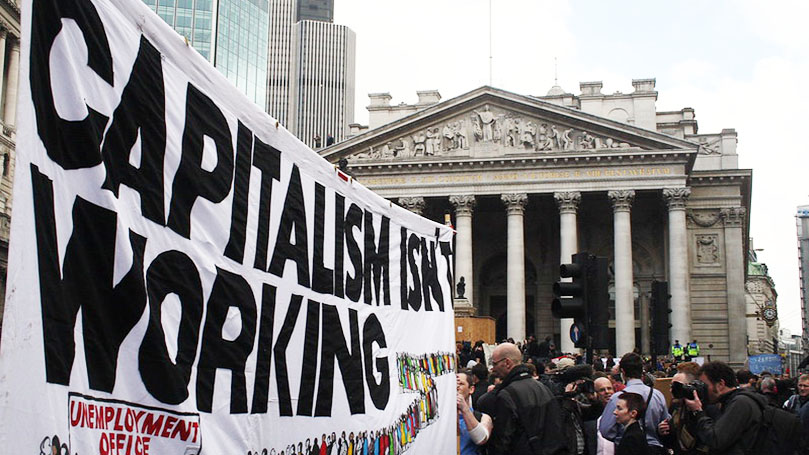
More than 50 million people in the U.S. are out of work, and Donald Trump is on the golf course again. Despite promising swift action to restore economic growth, Trump is interested in restoring his golf swing. Indeed, his callous leadership of the federal government’s response to the COVID-19 pandemic, which has seen the death toll approaching 180,000, has bled into his party’s resistance to serious relief for working-class people.
Before the COVID-19 pandemic, the U.S. economy was already headed for disaster. While the unemployment rate was the lowest since the 2008 crash, nearly half of U.S. workers held jobs that paid poverty wages. According to a Brookings Institution report, 53 million workers earned a median wage of just over $10 per hour.
Most of the people in this category are women, people of color, and people trapped by low education levels. In fact, the low-wage workforce proved to be the fastest-growing section of the labor market in the U.S.
When the pandemic hit, 55 million workers were declared essential workers. Millions were low-paid agricultural workers, ironically many of whom are still unauthorized immigrants. Many are food workers, delivery personnel, and health-care workers. For a brief moment, the capitalist class pretended to care for their lives and well-being, while resisting any demand for a living wage, real health reform, and worker safety protections.
Profit is the real concern, after all.
Donald Trump failed to lead. He pointlessly fought the media, stupidly accused public health experts of trying to undermine him, and criticized real leaders like the Michigan governor. He referred to her as “that woman,” when it became clear that she would follow the science on stopping a pandemic rather than the capitalist class line on forcing everyone back to work.
He made downright moronic suggestions about increasing the use of antibiotics, ingesting disinfectants, and internalizing ultraviolet light as means of fighting COVID-19 infection. He pushed a drug proven to be ineffective in fighting the disease.
He encouraged his followers to “liberate” states where stay-home orders had been given and to defy the use of masks, directly leading to the spread of the virus and the dramatic rise in the number of deaths.
Trump does not care about the well-being of workers. He has no plan to raise their living standards. He refused to acknowledge the depths of an economic quagmire most workers found themselves in before the pandemic and are now struggling to survive since the economic collapse has arrived.
He prefers to pretend that nothing has happened.
Why is this the case? True to discredited “trickle-down” economic theory, Donald Trump believes that his tax cut for the rich—the ONLY piece of legislation his administration has successfully passed—stimulated investment in economic activity, creating new jobs.
But why are “new” jobs almost always dead-end and low-pay?
There are two issues here that reveal the weakening structural performance of the U.S. economy. And it is the structural deficiency that requires a radically new direction, which Trump cannot chart.
First, Trump’s plan to re-start the U.S. economy in pandemic conditions shows his cruel, corrupt leadership. He is blocking meaningful relief for tens of millions of unemployed to intensify pressure on them to return to work without proper public health guidelines that could protect them from COVID-19.
His allies in the U.S. Senate refuse to vote on new relief measures for workers. Meanwhile, Trump is making campaign videos that falsely present him as caring about workers.
By contrast to this cold-hearted disregard for workers’ well-being, Trump and his allies rapidly passed a massive relief package for millionaires and billionaires through the Paycheck Protection Program. That program has reportedly resulted in massive giveaways to Trump’s donors, his family members, powerful politicians, and already-successful corporations.
These payments to corporations allowed massive stock buybacks, which kept their share prices up, the appearance of high profits, and protected CEO bonuses, without producing any new economic activity.
These payments should be seen as a massive government down payment to corporations on their employees’ future work, now idled by the pandemic. It is how capitalism works: workers produced not only the value that pays their wages, they produce the value that is stolen from them to make up the employers’ profit margin. When workers can’t work, profits vanish. So big companies—who are too big to fail—demand and get profits on advance from the federal government.
The second major weakness is that when the economy re-opens and the mass of workers return to work, most can only count on returning to low-wage, dead-end jobs.
The reason this condition exists in the first place is complicated. It is related to declining educational quality across the country, the labor movement’s weakness, and a growing alignment of government with private corporate interests. Observers refer to this combination of policies as the neoliberal consensus.
Perhaps most insidiously, however, the main driver is that U.S.-based capitalism’s corporate policies are focused solely on self-interest, unplanned profit growth rather than long-term, planned activities that are designed to produce positive social benefits. Some will say, “but self-interest is how capitalism works. That’s how the U.S. economy grew so strong in the first place.”
Despite the distortion of reality behind that claim, the 2008 Great Recession exposed the U.S. economy’s underlying weakness due to its dependence on debt, especially for the working class. Total consumer debt in 2008 stood at $13 trillion, when car loans, mortgages, and credit card debts are added up. In the first quarter of 2019, the total was $14 trillion. Student loan debt alone has more than doubled in the 11 years since the Great Recession.
Since the 1980s, stagnant profit rates and slow economic growth caused a fundamental shift in economic thinking from demand-driven economics based on real wage growth for the mass of workers to an economic model dependent on consumer debt for growth. This latter model has also seen a downward pressure on real wages to drive higher profits. However, the logic of this model prevents the mass of workers from repaying their debts and periodically forces the economy into crisis.
Trump has no plans to resolve this fundamental structural weakness, the fundamental contradiction within U.S. capitalism. The scramble to demonize China and contain its global economic growth suggests a desperate agenda. But, like those of most of his class allies, his personal goal is to make as much money as he can and get out while the getting is good.
Trump hasn’t even tried to pretend that he cares about American workers until this reelection campaign, when he needs their votes to reinstall himself as the leader.
Image: Jonny White, Creative Commons (BY 2.0).


 Join Now
Join Now